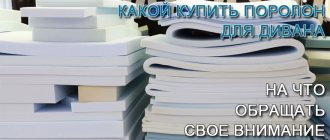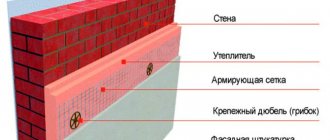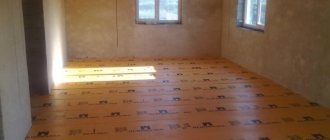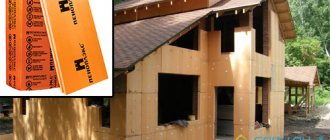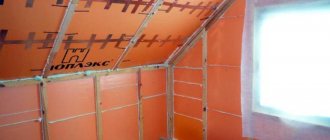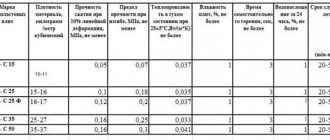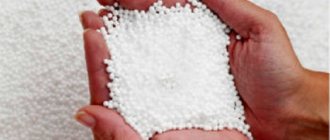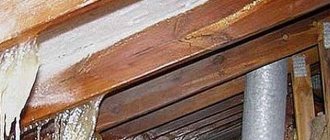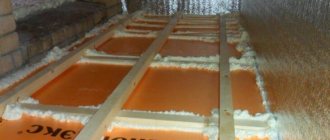We have already written about what Penoplex 30 mm lightweight insulation can do in an article on the website, now let’s talk about other types of products from the popular brand.
Are you planning to use Penoplex extruded polystyrene foam for thermal insulation of an object, but can’t figure out the brands and density of insulation? Especially for you, we have systematized useful information in this article so that you can easily understand the densities of Penoplex and give even an experienced builder a head start.
Old classification of Penoplex insulation
Initially, the plant produced three types of extruded polystyrene foam depending on density: Penoplex 35 (with a density of 35 kg/m3), Penoplex 45 (45 kg/m2) and Penoplex Standard (32 kg/m3). In addition to density indicators, insulation materials have different sizes, thickness, compressive strength, flammability group and KMO class. The scope of use of each insulation also varies.
- Penoplex 35 density is one of the most popular brands of insulation, which was used to insulate various types of enclosing structures: foundations and plinths, operated and unused roofs, floors and walls.
- Penoplex 45 coped with increased loads when insulating foundations, ground floors, as well as highways and railways, runways, bridges, tunnels in the Far North and on heaving soils.
- Penoplex STANDARD was most often used to insulate swimming pool bowls, floors and shallow foundations, fire tanks, settling tanks and wells.
Previously, Penoplex extrusion was produced in standard thicknesses from 20 to 100 mm, width 600 mm and length 1200 mm. We sorted out the old parameters. It's time to find out the modern classification of Penoplex.
Density table for Penoplex 35, 45 and Standard insulation
| Density | Length, mm | Width, mm | Thickness, mm |
| 35 | 1200 | 600 | 20, 30, 40, 50, 60, 80, 100 |
| STANDARD | 1200 | 600 | 20, 30, 40, 50, 60, 80, 100 |
| 45 | 2400 | 600 | 40, 50, 60, 80, 100 |
Insulation technology
Penoplex Base is excellent for insulating both floors and walls.
Insulation of a wooden floor with joists
Firstly, all damaged areas on the boards and joists are replaced. Next, all wooden surfaces are impregnated with antiseptic agents to prevent rotting. Recesses and cracks found on the boards must be filled with special wood putty.
Next, all wood surfaces are primed . After the primer has dried, the installation of insulation sheets begins. They are cut according to the distance between the joists and the length of the room and placed on boards.
The joints between the foam boards must remain as tight as possible ; they are additionally secured with construction tape. Next, sheets of vapor barrier material are laid overlapping on the foam boards. Boards, plywood or chipboard are attached to the vapor barrier layer. The final stage is the installation of flooring (linoleum, laminate, parquet).
Floor insulation when laid on the ground
When insulating floors in a house with a pile or strip foundation, the method of laying insulating material on the ground is used. First, you need to level the layer of earth and then compact it.
Next, crushed stone and gravel are poured onto the ground. Sand is then poured in and compacted. are laid on the sand “pillow” , starting from the corner, pressing tightly.
To protect against moisture penetration, a waterproofing membrane is laid on the foam sheets so that its edges extend 10-15 cm up the wall.
To strengthen the structure, the screed is reinforced with metal mesh. Next, a cement-sand mixture is used for the screed, which is poured over the mesh. Finally, after the cement layer has completely dried, linoleum is laid on it or laminate or parquet is laid.
Insulating the floor under the screed
When using this method of insulation, it is recommended to choose a modification of the penoplex Foundation .
Insulation of walls from the inside
Penoplex Base is often used when insulating the internal walls of a house . Firstly, the walls are cleaned of the old coating and a layer of primer is applied. Next, they begin to attach the foam sheets to the walls.
First, the underside of the base foam sheet is passed with a needle roller to ensure better adhesion. Next, an adhesive layer is applied to the sheet, the sheet is applied to the wall surface and held for half a minute.
Gluing begins from the bottom corner, then moving up and to the side. The glued foam sheets are additionally fixed with plastic dowels with an umbrella cap. After the glue has dried, use foam to fill the gaps between the sheets.
Important : recesses more than a centimeter wide must be filled with scraps of foam sheets.
At the next stage, the fiberglass plaster mesh with glue or using dowels. Next, a leveling layer of plaster is applied, and then a finishing layer of putty. Finally, the surface is painted or wallpaper is glued to it.
Insulation of external walls
When insulating the walls of buildings and structures from the outside, it is recommended to use Penoplex Facade , which contains special flame retardant substances to reduce the risk of fire.
Classification of Penoplex in a modern version
Old brands are a thing of the past, and information on the Internet about the availability of these goods in warehouses is clearly irrelevant.
This is easy to determine if you contact the managers of such online stores. Attention! The manufacturer has every right to rebrand and change sizes and technical characteristics in order to improve the quality of its products.
We are official dealers of the Penoplex plant in the Moscow region, therefore we offer the latest information about the products supplied. From previous types of thermal insulation, Penoplex 45 insulation is still produced, which does not lose popularity among developers. You can purchase thermal insulation material of this brand of the required size and thickness from our company at an excellent price right now.
- Penoplex Roofing. Insulation with a density of 28-33 kg/m3 is an improved analogue of the good old Penoplex 35, the thickness of which varies from 20 to 150 mm, length 1185 and 2370 and thickness 585 mm. The slabs are indispensable for insulating all types of roofing systems.
- Penoplex pitched roof. The material was specially developed by engineers for effective thermal insulation of pitched roofs in private suburban construction. Available in thicknesses of 100, 120 and 150 mm.
Penoplex Foundation. Corresponds to the old type Penoplex 35 without fire retardant additives and is produced in thicknesses of 50 and 80 mm, length 1185 and width 585 mm. Recommended for insulating loaded structures and can be used for at least 50 years without deformation or loss of thermal insulation properties.- Penoplex Comfort. A real gift for private owners, corresponding to the outdated Penoplex 31C type with a density of 25-32 kg/m3. The range of thicknesses is presented in sizes from 20 to 150 mm. The slabs are indispensable for thermal insulation of loggias and balconies, walls of apartments and country houses.
- Penoplex Geo. High-density slabs are designed for insulation of various recessed structures. The thickness of the slabs varies from 20 to 150 millimeters, and the increased length of up to 2370 mm makes it possible to reduce the number of joints and minimize cold bridges.
- Penoplex Base. Such insulation allows you to thoroughly protect the base, walls and pitched roof from freezing for decades to come. The dimensions of the material fully correspond to Penoplex Geo insulation, and the density of Penoplex Basis ranges from 28 to 35 kg/m3.
- Penoplex Facade. The material is an updated version of Penoplex 31 with fire retardants and, as its name implies, is intended for insulation of facade systems of private and multi-storey houses, industrial buildings, as well as heat and sound insulation of walls and partitions. The standard sizes of the slabs correspond to the two previous brands.
Note: the longest slabs from the entire Penoplex line include the industrial insulation PENOPLEX®BLOK, up to 3000 mm long, designed for thermal insulation of roads.
The range of modifications of Penoplex insulation has expanded significantly. Now you can quickly select the appropriate material, since the name of the series is consonant with the structures where it is applicable. Penoplex Roofing, Facade, Geo and others. We invite you to watch the video to understand how the foundation of a house is insulated with Penoplex Foundation slabs.
Table of technical characteristics of modern Penoplex brands
| Name | Test method | Dimension | Slab indicator |
| Compressive strength at 10% linear deformation, not less | GOST EN 826-2011 | MPa (kgf/cm2; t/m2) | 0,2 (2,0; 20) |
| Water absorption in 24 hours, no more | GOST 15588-86 | % by volume | 0,5 |
| Fire resistance category | F3-123 | group | G3 |
| Thermal conductivity coefficient at (25±5) °C | GOST 7076-99 | W/(m×°K) | 0,030 |
| Calculated thermal conductivity coefficient under operating conditions “A” | SP 50.13330.2012 | W/(m×°K) | 0,031 |
| Calculated thermal conductivity coefficient under operating conditions “B” | SP 50.13330.2012 | W/(m×°K) | 0,032 |
| Sound insulation of partition (GKL-PENOPLEX® 50 mm-GKL), Rw | GOST 27296-87 | dB | 41 |
| Standard sizes | Width | mm | 585 |
| Length | mm | 1185; 2370 | |
| Thickness | mm | 20; 30; 40; 50; 60; 80; 100; 120; 150 | |
| Operating temperature range | THAT | °C | -100 … +75 |
Myths about Penoplex that are worth learning about!
Myth 1. The higher the density of penoplex, the warmer the house will be. It is enough to turn to primary school physics to understand: light slabs of low density will retain heat better, but their strength characteristics will be significantly lower.- Myth 2. Extruded polystyrene foam Penoplex with a density of 100 kg/m3 exists. In fact, all attempts by consumers who want to find such material are in vain. The maximum value of slabs of this brand does not exceed 45 kg/m3.
- Myth 3. Extruded polystyrene foam insulation has been banned for use in the USA and European countries due to its toxicity. In fact, since 1995, foaming technology using freons has been banned. Foaming of Penoplex is carried out using carbon dioxide, which means the material is 100% environmentally friendly.
Are you ready to order thermal insulation boards made from extruded polystyrene foam Penoplex 35 of the required thickness? Or maybe you want to get a free insulation consultation on choosing density and sizes? Call us at +7 (495) 565-39-92 right now!
Let's consider the pros and cons
Are you considering using eco-friendly insulation when building or renovating a private home? If yes, that's great! There are several types of insulation. Extruded polystyrene , or penoplex, is one of the most popular.
Advantages
This material has many advantages . Here are some of them:
- Extremely low thermal conductivity coefficient . Only 0.032 W/(m×°K) - 22 times less than that of sand-lime brick.
- Moisture resistance . The granules of Osnova products do not absorb water, so the performance characteristics remain normal.
- Decent durability . The material holds its shape well and is difficult to damage or tear, which cannot be said about foam plastic.
- High sound insulation . A nice bonus when there is a noisy highway outside the window, or the house is located in a densely populated area.
- Ease of installation . tongue-and-groove locks on the edges of the sheets , so during installation you can do without adhesives.
- Biostability . It is not destroyed by putrefactive bacteria and mold fungi.
- Environmental friendliness . The thermal insulation contains no harmful substances. After installing it indoors, you won’t have to keep the windows wide open for a month.
- Long life span . The manufacturer assures customers that the product will serve faithfully for at least 50 years.
Flaws
Penoplex Osnova thermal insulation also has disadvantages :
- High flammability . The insulation belongs to class G4 , which means that its flue gases heat up to temperatures above 450 °C. Even if the polymer just starts to smolder, you will have to stay away from it.
- Low vapor permeability . The walls will hardly “breathe”, and the windows will fog up, so you need to equip the room with a high-quality ventilation system.
- Susceptibility to UV rays . The insulator is “afraid” of ultraviolet radiation. Under the influence of the sun, the structure of the granules quickly collapses . The solution is to coat the polystyrene with a finish.
The material is lightweight, making it easier to work with. You can cut the sheets using a regular painting knife .
